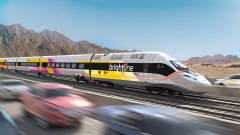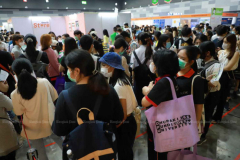The $12 billion, electric rail would travel about 218 miles in two hours and 10 minutes and transport up to 11 million passengers a year

There are typically two ways travelers move between Los Angeles and Las Vegas: By car, drivers risk sitting in traffic that can double the four-hour drive time. Air travel comes with the typical risks of lost luggage, canceled or delayed flights and high costs for a journey that takes roughly five hours door to door.
A Miami-based company intends to offer a third option that sounds like something out of Switzerland or Japan: a high-speed train that will cover 218 miles between Las Vegas and the Los Angeles area in two hours and 10 minutes.
“There will be a train in the United States operating in excess of 186 miles an hour in the very near future,” Mike Reininger, CEO of the company planning to build the train system, said last week at a high-speed rail conference in Washington D.C.
“It is the only fully shovel-ready project that can be delivered in short order in the United States,” he said, adding that he hopes the project “will finally plant the flag of what high-speed rail in America can and should look like.”
Reininger announced that the project will be ready for groundbreaking by the end of the year and will be finished by the 2028 Olympic Games in Los Angeles.
“If you were gonna come out and put yourself on the stage, is there a better way to do that than at the opening ceremonies at the ’28 Olympics?” he said. “That is our objective.”
Here’s what we know about the high-speed rail so far.
What’s the cost to build high-speed rail to Vegas?
The high-speed rail is estimated to cost $12 billion, 70 percent of which will come from private investment. Reininger’s company, Brightline West, hopes the other 30 percent will come from the federal government.
Last month, Brightline West applied for a $3.75 billion grant from the Biden administration to fast-track the project. The grant proposal was 4,500 pages, Reininger said, adding that the company has more than covered its bases.
Shortly after applying for the grant, a bipartisan group of California and Nevada lawmakers wrote a letter to U.S. Transportation Secretary Pete Buttigieg expressing their strong support of approving the dollars.
“This unprecedented funding opportunity for intercity high-speed rail will unleash private investment at a critical moment for our nation, demonstrating the potential for public-private partnerships and planting a flag for American high-speed rail,” the lawmakers wrote.
They went on to praise the rail plan for job creation, the environment and the potential to boost tourism across the region.
What it will take to complete the Vegas-to-LA high-speed rail line
In order to meet the goal to open the rail before the 2028 Olympics in Los Angeles, Brightline West will have to lay about a mile of track a day for 270 days following years of preparation, according to company estimates.
In all, the company will use 70,000 tons of rail and 750,000 railroad ties for the rail, which will be electric.
“We think it will be the greenest form of transportation anywhere in the world,” Reininger said.
Another component he’s proud of is Brightline West’s commitment to use union workers during the project and once it’s finished.
The line will include three stations, with the two main ones being in Las Vegas and the Los Angeles suburb of Rancho Cucamonga. The third one will be roughly halfway in between in Victorville, California.
“We have invested, to date, over $600 million of entirely private funding into acquiring all of the critical land and completing the right of way from endpoint stations for the entire system,” Reininger said. “We have that under control today.”
Once finished, the system will be capable of transporting 11 million people a year, he said.
Brightline’s track record
Brightline West’s sister company began sharing the Florida East Coast freight line between Miami and West Palm Beach in 2014 and is building an extension to Orlando.
Running that rail has taught Brightline that “it’s only partially effective to get people excited about what you’re doing,” Reininger said, adding that conceptual ideas and theoretical outcomes have limited effectiveness.
“But when you bring (people) into a shiny new station, and you let them order themselves a nice drink … and it smells great in the facility and you let their butts hit this leather seat in a very comfortable ride, the conversation gets a whole lot easier,” he said.

Brightline conducting high speed tests along SR 528 corridor
Check out the images of Brightline’s higher-speed train tests held on the newly constructed tracks on the SR 528 corridor.
Brightline
High-speed trains running through urban areas have drawn criticism for numerous crashes with vehicles at rail crossings. Investigators found that none of the deaths were the





